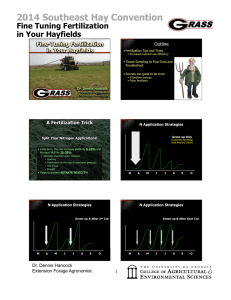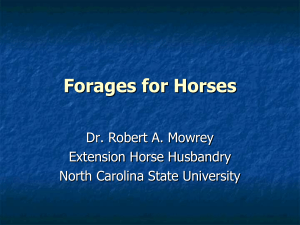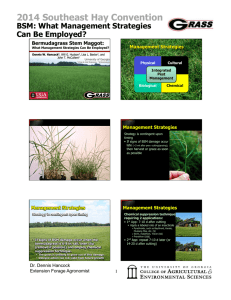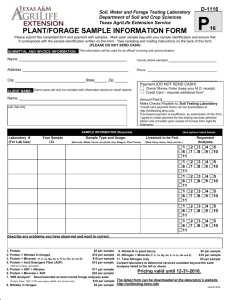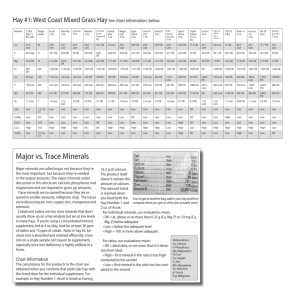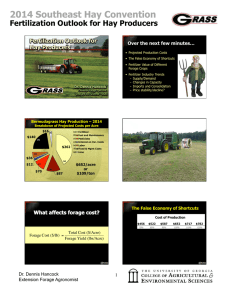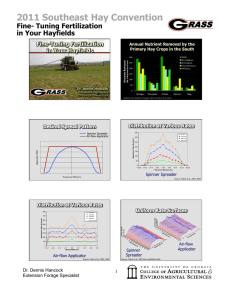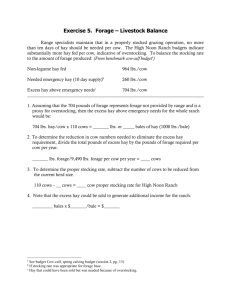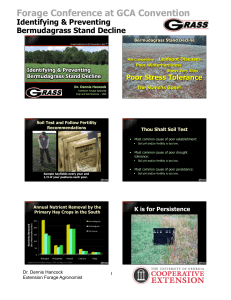2008 Hay Production School Fertilization Strategies for Hay Producers
advertisement
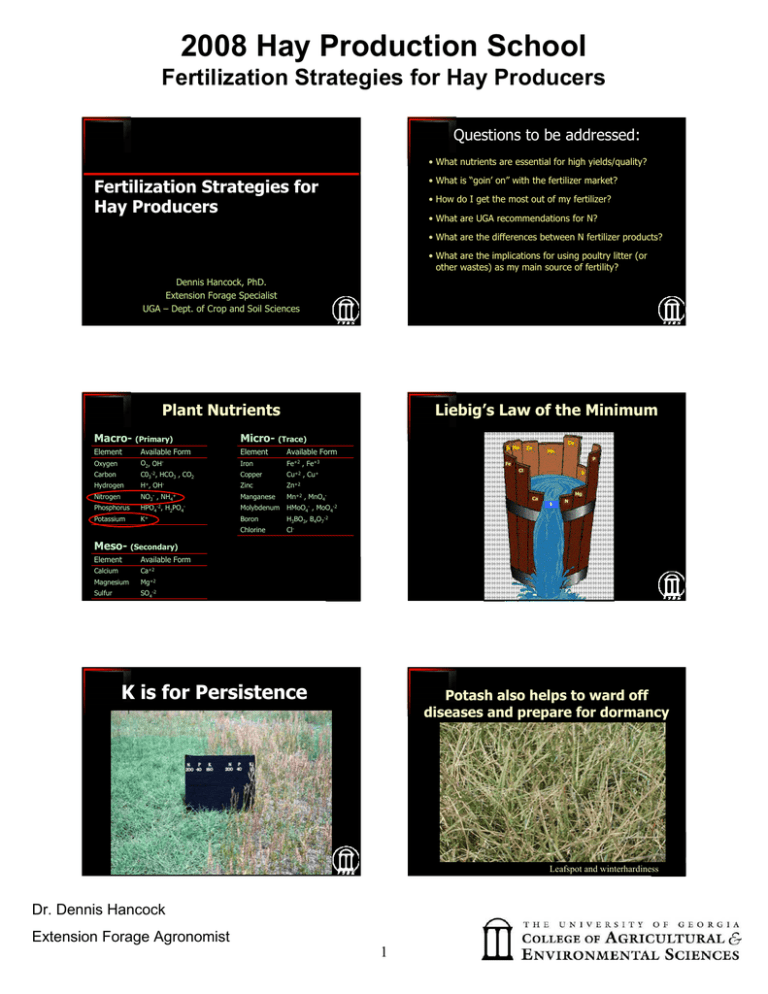
2008 Hay Production School Fertilization Strategies for Hay Producers Questions to be addressed: • What nutrients are essential for high yields/quality? • What is “goin’ on” with the fertilizer market? Fertilization Strategies for Hay Producers • How do I get the most out of my fertilizer? • What are UGA recommendations for N? • What are the differences between N fertilizer products? • What are the implications for using poultry litter (or other wastes) as my main source of fertility? Dennis Hancock, PhD. Extension Forage Specialist UGA – Dept. of Crop and Soil Sciences Plant Nutrients Liebig’s Law of the Minimum Macro- (Primary) Micro- (Trace) Element Available Form Element Available Form Oxygen O2, OH- Iron Fe+2 , Fe+3 -2, Carbon C03 Copper Cu+2 Hydrogen H+, OH- HCO3 , CO2 Zinc Zn+2 , Nitrogen NO3- , NH4+ Manganese Mn+2 , MnO4- Phosphorus HPO4-2, H2PO4- Molybdenum HMoO4- , MoO4-2 Potassium K+ Boron H3BO3, B4O7-2 Chlorine Cl- S Mo Cu Zn Mn P Fe Cl Cu+ B Mg Ca K N Meso- (Secondary) Element Available Form Calcium Ca+2 Magnesium Mg+2 Sulfur SO4-2 K is for Persistence Potash also helps to ward off diseases and prepare for dormancy Leafspot and winterhardiness Dr. Dennis Hancock Extension Forage Agronomist 1 2008 Hay Production School Fertilization Strategies for Hay Producers High Fertilizer Prices Are Probably Here To Stay K is the Key to a Good Stand • Inorganic N fertilizer is directly tied to the energy (natural gas) market. Haber-Bosch process (N2 -> NH3) High international demand Cheap dollar on the world market • Potassium is no longer the cheap nutrient it once was. Potassium Production/Consumption - 2006 High international demand It is mostly an international product Production had been reined-in Mine failures (flooding, particularly in Eastern European countries) Get the most out of your fertilizer bill… U.S. < 2.0 Soil test each hayfield each year! “Add only what is needed” “Lime is the cheapest fertilizer there is.” Dr. Dennis Hancock Extension Forage Agronomist 2 2008 Hay Production School Fertilization Strategies for Hay Producers How Soil pH Affects Availability of Plant Nutrients Low Soil pH = Aluminum Toxicity Low Soil pH CaCO 3 Lime Quality CaCO3 Rule: At least 90% must pass a 10 mesh sieve. Ca2+ + CO3 pH = 4.5 Mg2+ H+ Soil Soil Al3+ Al3+ Ca2+ Al3+ Ca2+ H+ Ca2+ HCO3 + Al(OH)3 + Sieve Size K+ pH = 6.5 Dr. Dennis Hancock Extension Forage Agronomist 3 % of total ≤ 10 mesh 12 10-20 mesh 17 20-35 mesh 55 ≥ 35 mesh 16 2008 Hay Production School Fertilization Strategies for Hay Producers Hybrid Bermudagrass Yield Response to N Rate Lime Quality Affects Neutralizing Time 14.0 12.0 Average or “Normal” Response 10.0 Forage Yield (tons/A) @15% moisture 8.0 6.0 4.0 2.0 0.0 0 100 200 300 400 500 600 700 800 Nitrogen Rate (lbs N/A) Hybrid Bermudagrass Yield Response to N Rate Hybrid Bermudagrass Yield Response to N Rate 14.0 12.0 10.0 Forage Yield (tons/A) @15% moisture 8.0 6.0 Yield Limitations - Drought, low fertility, etc. - Inefficient application timing - Less effective N source 4.0 2.0 0.0 0 100 200 300 400 500 600 700 800 Nitrogen Rate (lbs N/A) SPLIT YOUR NITROGEN APPLICATIONS! Other Common Nitrogen Sources Nitrogen Source Ammonium Nitrate Amm. Sulfate Anhyd. Ammonia** UAN Solution 32% (35% U + 45% AN) 28% (30% U + 40% AN) Urea • Long-term, this can increase yields by 1200-2400 lbs/acre and increase NUE by 25-30% Urea (Sulfur-coated) Poultry Litter Especially important under extremes ¾ Leaching ¾ Volatilization (in the case of urea-based products) ¾ Late freeze ¾ Drought * Content Approx. CCE* 34-0-0 -61 21-0-0-24 -110 82-0-0 -148 32-0-0 -55 28-0-0 -49 46-0-0 -81 38-0-0-16 -118 3-3-2 ~10 Approximate CaCO3 (limestone) equivalent per 100 lb of product. For example, it will take 61 lbs of pure lime to neutralize the acidifying effect that ammonium nitrate has on the soil. ** Must be injected into the sod. Not recommended for bermudagrass production. Dr. Dennis Hancock Extension Forage Agronomist 4 2008 Hay Production School Fertilization Strategies for Hay Producers The Effectiveness of Some Alternative N Sources at Low, Medium, and High Fertilization Rates on Hybrid Bermudagrasses (Relative to Ammonium Nitrate). Nitrogen Source Ammonium Nitrate Amm. Sulfate Anhyd. Ammonia UAN Solution Urea Alternative N Sources Fertilization Rates < 200 lbs* 250-350 lbs > 400 lbs 100% 100% 100% 95-97% 95-105% 60-70% 92-94% 93-95% 94-95% 70-75% 85-92% 92-95% 79-82% 82-92% 88-93% Take-home message: If you have to use a urea-based product, be careful about cutting your rate back too much. - They are relatively less effective at low rates. * Actual lbs of N per acre per year. Source: Burton and Jackson, 1962; Silveria et al., 2007. Too much of a good thing? Poultry Litter for Hay Fields • Weed pressure does increase Not a source of weed seed Changes the fertility and makes broadleaf weeds more competitive. • Potassium fertilization may not be adequate Poultry Litter: 3-3-2 Ideal bermudagrass fertilizer: 4-1-3 • May result in excessive sulfur levels Some evidence for a link to copper deficiency in cattle. Resources on CD Fertilization Strategies for Hay Producers QUESTIONS? www.georgiaforages.com Dr. Dennis Hancock Extension Forage Agronomist 5


